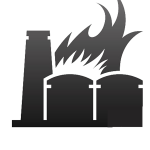FIRE SAFETY PRODUCTS & SERVICES

fire on home
In the event of a fire, remember that every second counts, so you and your family must always be prepared. Escape plans help you get out of your home quickly.

fire on office
Always familiarize yourself. Remember that in a fire situation, smoke is blinding and will bank down in the rooms and hallways.

fire on industry
Never ignore a fire alarm! Your first reaction should be to grab your room keys, alert the people around you, and go.

On airoplane
In an airplane, fire is a four-letter word. If you aren’t prepared to extinguish it, your chances of survival are slim at best..

fire on car
Stop the car and turn off the ignition when fire on car.Get every person out of the car, and don’t allow anyone to go back to retrieve personal items.
At a glance

An addressable fire alarm system is made up of a series of fire detectors and devices that are connected back to a central control panel.
With addressable systems, each device has an address or location, enabling the exact detector that was triggered to be quickly identified. This makes addressable alarm systems ideal for large buildings, particularly commercial premises spread over a wide area.
Advantages of addressable fire alarms
- Quickly determine the location of a fire.
- Specific actions can be programmed by the user.
- Reduced likelihood and better handling of false alarms.
- More reliability, less likely to lose connection.
- Lower overall cost of wiring.
- Ability to monitor integrity of the system, with detector health checks.
Fire alarm systems that can be programmed
One of the biggest advantages of addressable fire alarm systems is that they can be configured so that a specific action triggers a specific response.
For example, cause and effect programming can be used to say that a particular ‘cause’ such as activation of a fire detector, has the effect of alarms sounding in a specified area and the system being put on alert mode in another. This means that phased evacuation can take place, with priority areas evacuated first. Each area of a building can then be evacuated one at a time, which allows safer fire evacuation procedures in large buildings.
Reduce false fire alarms
False alarms cause disruption and can be costly, so it’s in any business’s interests to minimise their impact and reduce the likeliness of them occurring in the first place.
One of the advantages of addressable fire alarms is that they can allow air to be monitored through the detectors, so if air is contaminated for example with dust (which can activate some fire alarm systems) then a ‘pre-fire’ warning is triggered. This allows investigation to take place, so any issues can be rectified before a full scale false activation of the system takes place.
Addressable fire alarms are more reliable than conventional
Due to the way that addressable alarm systems are connected, any breaks in the circuit caused by damage are less likely to result in devices being disconnected. Unlike conventional systems, all devices are wired up on a loop and are connected to the panel unit at both ends. Therefore if connection breaks at one end, devices will still be connected.
Cost of wiring up alarm system is cheaper
Addressable fire alarms are wired on a loop, which is basically a circuit that connects the system to other devices such as sprinkler systems, call points and detectors. With conventional fire systems each zone and sounder circuit has its own wire, so the cost of wiring can potentially be higher, depending on how many devices need connecting up.
Monitoring and checking all individual fire detectors for faults
Fire alarms are arguably one of the most critical aspects of fire safety on your premises. Another benefit of addressable fire alarm systems is that all devices can be individually monitored and checked for faults, which makes maintenance easier. If an issue is found with a particular detector for example, then a notification will be received by the central control panel.
Having an addressable system therefore means that any problems can be discovered immediately so that they can be rectified, ensuring that everything is in good working order should an incident occur.

Product Specification
| Brand | Bosch |
| Usage | Office Buildings, Residential Buildings |
| Feature | Easy to install |
| Minimum Order Quantity | 50 Piece |
Product Description
We are one of the most reliable companies in this domain and are into offering Bosch Smoke Detector.

Conventional panels have been around ever since electronics became small enough to make them viable. They are no longer used frequently in large buildings, but are still used on smaller sites such as small schools, stores, restaurants, and apartments
A conventional system employs one or more initiating circuits, connected to sensors (initiating devices) wired in parallel. These sensors are devised to decrease the circuits resistance when the environmental influence on any sensor exceeds a predetermined threshold. In a conventional system the information density is limited to the number of such circuits used. At times, a floor plan of the building is often placed near the main entrance with the defined zones drawn up, and LEDs indicating whether a particular circuit/zone has been activated. Another common method is to have the different zones listed in a column, with an LED to the left of each zone name.
The main drawback with conventional panels is that one cannot tell which device has been activated within a circuit. The fire may be in one small room, but as far as emergency responders can tell, a fire could exist anywhere within a zone. The same applies to coded panels, which nowadays are no longer made, but can be found in old systems. These, if the decision is made to keep them, are “grandfathered” in under NFPA regulations.
ADVANTAGES OF CONVENTIONAL FIRE ALARM SYSTEMS:
- Cost effective for small applications.
(Note: The larger the system the less competitive the price mainly due to higher installation costs.)
DISADVANTAGES OF CONVENTIONAL FIRE ALARM SYSTEMS:
- Cost, not competitively priced for larger systems.
- Detection of smoke or a fire is done by zone, which could be multiple areas rather than specifying a specific location. This could delay emergency responders from locating the fire.
- Conventional panels are often called “dumb” panels because of the inability to provide detail information, such as…
- Device locations.
- No details on event history.
- No internet connection for notification of alarm/trouble/supervisory events.

Circuit Plug-in Module, doubling the address points to 508. The panel has a compact and solid metal housing with a keyed lock and a removable dead front door to access electronics. It features surface and semi-flush mounting options. On the front of the panel, six light- emitting diodes (LEDs) show Fire, Carbon Monoxide (Gas) Alarm, Power, Supervisory, Silenced, and Trouble conditions. The built‑in keypad can be used for total system control and programming even when wearing fireman gloves. In addition, a large 4‑line by 20‑character alphanumeric LCD display shows programmed device point information. Four keys enable Drill, Reset, Silence, and Acknowledge functions.